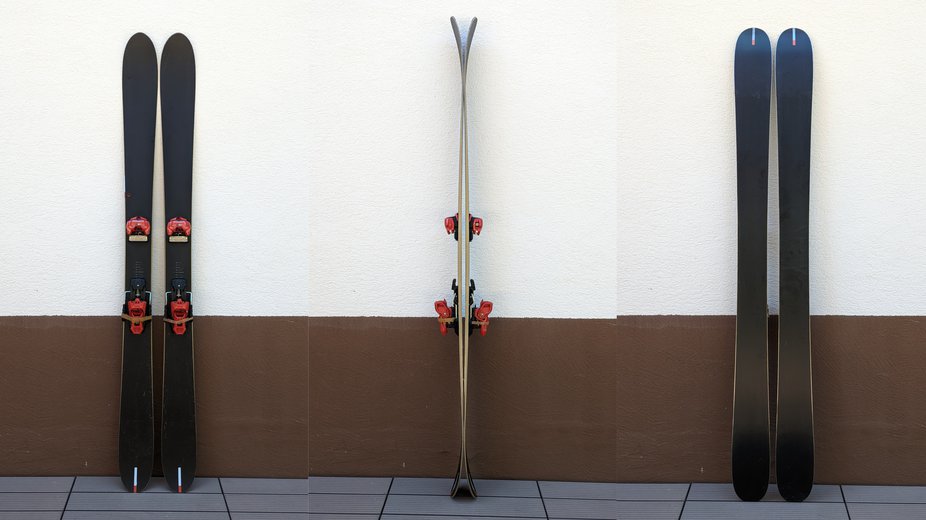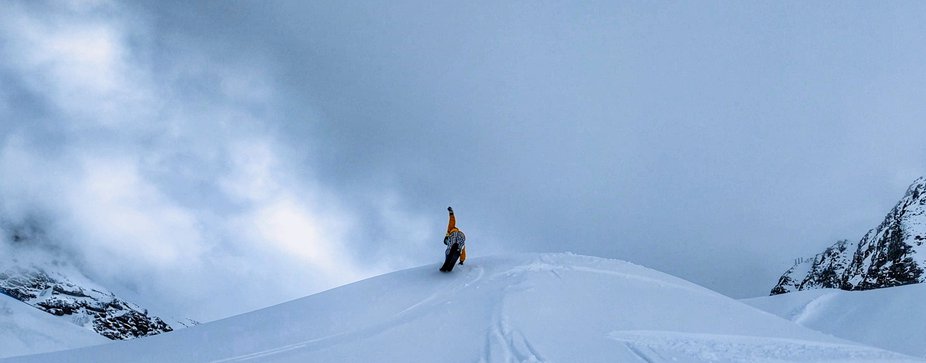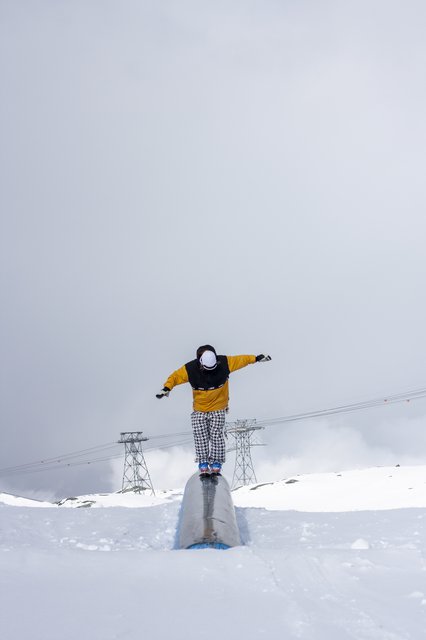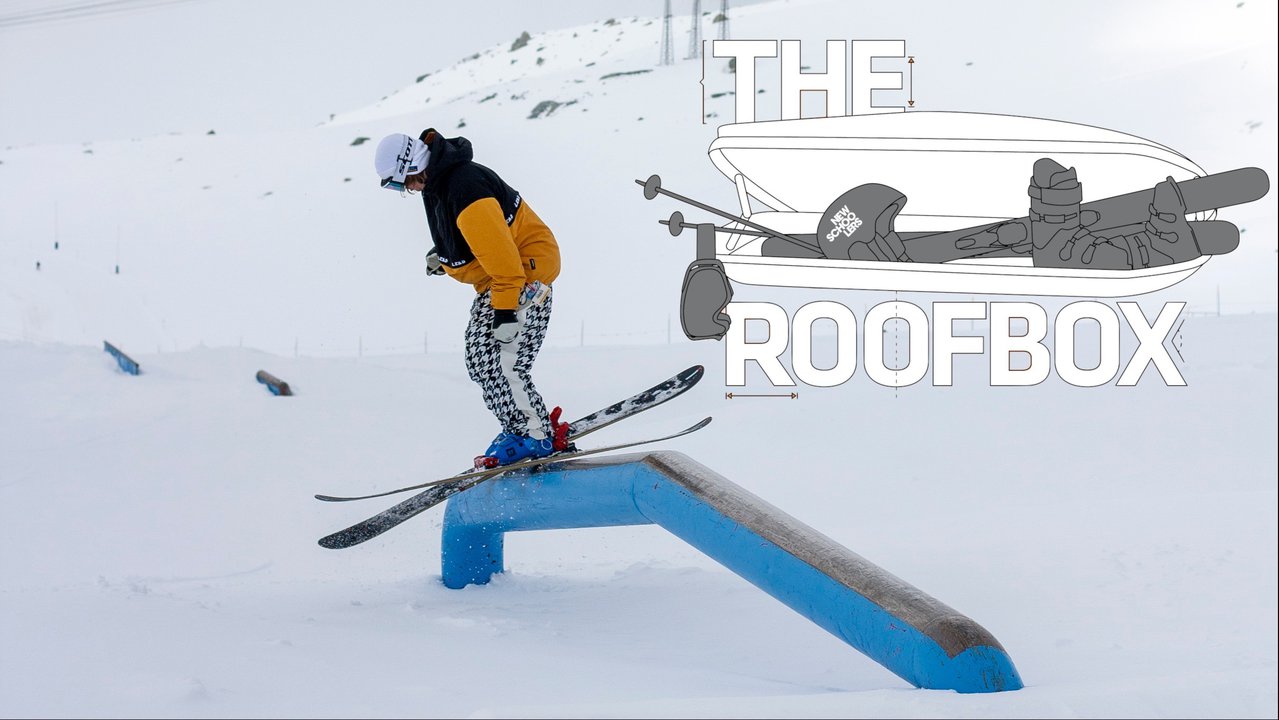Ski: Season Pass 2023
Reviewer height/weight: 5’9, 150lbs
Ski weights: 1819 & 1834g per ski
Length skied: 185
Actual length (with straight tape): 183.5
Quoted Dimensions: ?
Measured Dimensions: 147-116-144
Mounted: -2.5cm from true center
Bindings: Tyrolia Attack 17
Locations: Saas-Fee, Zermatt
Conditions skied: Powder, crud, park, groomers
Days Skied: 6
_
Photos: Hanne Lundin
Season Eqpt. has burst onto the ski scene with what are simultaneously some of the plainest and most exciting skis out there. The all-black topsheets, bar a small red circle logo (which got stolen by a Swiss telecoms network, hilarious) and plain black bases are only really eye-catching in their absence of well, anything eye-catching. I like the evergreen thought process behind them, and I like them to look at, but I couldn’t call them visually exciting. The shapes, however, designed with Eric Pollard, are to my mind at least, by far the most interesting departures from ‘the norm’ on the market right now. They truly are exciting and different, and the Pass is no exception.
_
Shape/Flex/Construction:
A (relatively) lightweight ~116mm pow ski aimed at backcountry freestyle and touring is certainly nothing new. But the Pass builds on the direction Eric’s skis have been taking in recent years, eschewing long rocker lines, with huge tip/tail splay and straight sidecuts. Instead, we have a ski that upon taking it out of the box, had me looking at it thinking ‘this can’t possibly work’. By my measure, there is 28cm of tip rocker length and 27cm of tail rocker. Tip and tail height stand at just 55mm. Most modern park skis have more rocker than that, as does Season’s narrowest ski, the Kin. The tips/tails have a medium amount of taper and measure in at 147mm/144mm respectively. There’s also a generous amount of camber underfoot. These are pow ski dimensions with an all-mountain ski’s rocker profile.

The flex is not particularly extreme and feels gently progressive. They are slightly softer than the Season Nexus and without any obvious hinge points, but they are stiffer than Pollard’s skis from his Line days. They don’t feel super stiff underfoot but they are solid and they gradually soften towards the tips and tails without any obvious extremes. I don’t actually know what the sidecut of these is, but it feels on the shorter side when you ski them.
The construction features a lightweight paulownia core and uses carbon for added energy. The edges are pretty standard, wider than those you see on ultralight pow skis but probably not designed for heavy-duty rail days. By my measure, they are probably 1.8x2mm. The bases are the same sintered 7500 series bases found across Season’s line and it’s the best I’ve ever tried, simple as that.
_
On snow:
Groomers:
The first time I ski something new for these reviews, I almost always take them out on groomers while the edges are sharp to see how good they can be on trails before I start banging them into metal and rocks and stuff. These are 116mm underfoot and so they shouldn’t really be any better than manageable on groomers, but the Pass is remarkably good on edge. Skis designed with Eric as part of the team have always turned better than they possibly should. And I’m thinking all the way back to the Line Elizabeth and older EP pros, they were SOFT skis but they still skied pretty damn well for what they were.
The Pass turns the dial to 11 for what you can get out of a 116mm ski. With the minimal rocker, comes a lot of effective edges. About 70% of the ski is cambered and you engage a little more edge when you roll them over, leaving you with the majority of the ski engaged when on edge. Compared to most pow skis you have a ski with a huge amount more ski contact when on edge. And underfoot, there is plenty of camber and energy to support that edging, meaning you get not only passable but a fun and engaging groomer ski. Normally, I take a couple of groomer laps on wide skis for a review and call it good. 110mm+ skis aren’t easy on the ol’ knees and if I’m railing groomers all day, I’m going to be switching back to something narrower. But I actually enjoyed these enough to spend a few days scudding all over the hill on them, popping off random features, dipping into the cruddy sections just out of bounds, and having a blast.

They do still have some swerve to them
_
Crud:
The impressive groomer performance is backed up by solid performance in mixed snow, heavy snow, slush, and even to a degree, crud. Traditionally, this is the area in which ‘Eric skis’ have lacked. To this point, they’ve always been softer and lacked the power to push through. The Pass isn’t a stiff ski either but it is tending to the stiffer side of medium in this bracket and that gives it enough power to back up a very crud-friendly shape. The low, pointed (almost to the point of pinned) tips and tails cut through just about anything and despite the abundance of camber and grippy shape, I found them easy enough to throw sideways in most conditions.
Steeps:
I didn’t ski a ton of steep tight terrain on these, but I did take them down one fairly tight line (Kiwi Wall, via the new exit for those who ski Saas-Fee) and they handled it well. The top of the line is a fairly steep open bowl and they handled speed very well. In the tight lower section, they were easy enough to pivot around and shut down speed, although a more rockered powder ski like the Armada Whitewalker does pivot much more naturally.

Fun on the ice too
_
Pow:
I didn’t get to ski a blower day on these, but I did get one day of 30-40cm and that was enough for me to feel like I have a read on them in pow conditions generally. The snow was on the heavier side that day and they handled it well. At 116mm underfoot and 147mm in the tips, they are obviously going to ski powder decently, and they do. But with the minimal rocker, the camber and not being a particularly soft ski, they aren’t giving you that feeling of completely effortless float that pow bananas give you. They like to cut through the snow as much as they like to float on top of it, so they dealt with a heavier day very well. They go sideways comfortably given the shape of the ski but again, more rocker and more taper do feel better when thrown sideways.
There is no such thing as a free lunch and the performance these skis provide in so many areas does impact the one-dimensional, blower pow day performance. Like most people, I’m lucky to get one or two days like that a year and these are still a good pow ski. I have actually inducted them into my own quiver as the ‘pow ski’. It’s just that for those one or two epic days, there are better skis out there.
PS. For us mortls, it is harder to land switch on these in deep snow. Less tail rocker just makes that harder, no matter how clever your shaping wizardry is.
Touring:
They’re pretty light, though not ludicrously so. They are definitely light enough for 90% of people to use as a touring ski, but if you are doing a 5-6 our approach or huge ascents, there are lighter options. There is a huge plus of the Pass though which is that the long cambered section provides a ton of flat base traction compared to most powder skis. I felt much more locked in on these grip-wise than the Bent 110/Icelantic Nomad ‘105’ when skinning at relatively steep angles.
Park/Jibbing:
All the Season skis I’ve tried have had a tendency to be a bit too ‘bitey’, gripping unexpectedly on hard snow landings and the Pass, despite its width did have a bit of the same, with one or two heart-in-mouth moments where the skis felt like they decided to do their own thing. That aside, these are a lot of fun in the park, and for jibbing around. They are light enough that despite the length/width I felt ok spinning them. As it happened I was in Zermatt for a powder morning and took these into the park in the afternoon. Much to my surprise I really enjoyed them on rails. They were a bit much to spin on for my tired legs but I knocked out a couple of back 4s with surprising comfort. The swingweight is pretty good for the size, and I opted for a -2.5cm from true center mount (+1,5 of recommended) which no doubt helped with that.

They are moderately stiff and not very rockered, so there are easier fat skis to butter and surf around on generally than the Pass. But that doesn’t mean they aren’t a fun fat park ski because they are. They just feel a bit more grown up and capable of bigger things than the swervy super noodle fat skis you see in the park more often. I actually really liked them for a few park laps going bigger on slower tricks.
_
Mounting point:
There is nice flexibility in mounting point with the Pass, with marked points all the way from center to -8. At recommended-(4cm), to me, they feel slightly directional while retaining some freestyle feel. At -2cm they feel firmly jibby and I wouldn’t go further forwards than that. I didn’t try them at -6, but I think they would work great there for a more directional skier, and they’d float better there to boot.
_
Durability:
I’ve been impressed consistently with the build of all the Season skis I’ve tried and these were no exception. Built at Altenmarkt in the Atomic Factory, which has been consistently turning out great skis that have lasted me well, that isn’t a huge surprise. Combine that with Season’s impressively tough topsheets and relatively simple construction and I had no particular concerns about any of their skis that I tried. Solid stuff.
_
Comparisons:
Line Outline:
The Outline, along with the Bentchetler 120 perhaps, is probably the most jib-focused pow ski out there. Though there have been softer Line skis in the past, they are still definitely softer than the Pass. They go sideways and surf more naturally, thanks in part to the convex tip and tail, and they are easier to butter and play on wherever you are. They also handle the deepest of deep days better. But the Pass is much more capable in varied conditions, much more stable on landings, and in a totally different class within the resort.
Atomic Bent 110:
The Bent 110 was the ski I skied most frequently side by side with the Pass. It has a totally different rocker profile and approach to ‘versatility’ and it’s also lighter. It’s marginally the better ski for ‘free float’ on the deep days despite a narrower footprint, though skied with more focus, the Pass is probably the better pow ski overall. Like the Pass it’s a very versatile ski, and much lighter. But where the Bent 110 lacks (groomer performance, fun, etc) the Pass delivers in bucketloads.
Armada Whitewalker:
The Whitewalker is more powder focused than the Pass. It has the same width and even more pinned tips with hugely more rocker length and splay. It does handle the deep days better, goes sideways and switch with more easily and has plenty of backbone for crud. But skiing the Whitewalker in most conditions is much less engaging than the Pass. The Pass has plenty of energy and bounce to it, while still holding up well in all conditions. It’s lightyears better on groomed snow in my books and makes more sense as a resort ski in general.
_
Conclusion:
When Season sent me these skis as prototypes, I had no idea what to expect. I didn’t know anyone outside the company who had skied them and even when they arrived, I had no more information than ‘this is our wider twin tip ski’. No specs, no details of construction, nothing (which as an aside was pretty exciting from a review point of view, to have a totally blank slate). As mentioned earlier, when I first pulled them out of the box, my first reaction was ‘what the fuck are these?!’. They look like nothing else on the market and they look like they don’t make any sense at all. As it happens, they do ski like nothing else on the market, but they absolutely do make sense. In fact, they are wonderful, unique and a ton of fun.
Despite the size/platform, I think the Pass is a hugely versatile ski. They’re the sort of ski that is perfect for taking up the hill when it definitely snowed, but you don’t know how warm it was, or what the wind has done to the snow, etc. Most people like to have a 105mm ski with quite a bit of rocker for that kind of thing (Revolt 104, Prodigy 3, ARV 106, ON3P Jeffrey 108, etc) which is great if a bit of snow has fallen but not that great if it’s either totally shit or epicly deep. For me, the Pass is great if it’s deep, and still a lot of fun if the snow just isn’t great when you turn up. They can make for a fun, surfy groomer day of playing around or a pretty epic day in the pow and just about anything in between. If you like wide skis, these could be a one ski quiver and certainly, you could very happily own just these with a touring binding and 100mm ski and do it all without ever going wanting. I ended up skiing them a surprising amount at the end of the season, despite my knee not loving it, because I was having a blast in the slush and cut-up snow. If you live near an evo location I’d definitely recommend taking these for a spin. If you can't well, once you get over the surprise of the shape, give them a day or two to get used to them, I don’t think you’ll be disappointed, I certainly loved them.
_
Next up on The Roofbox - Icelantic Nomad 105 by @Twig


Comments